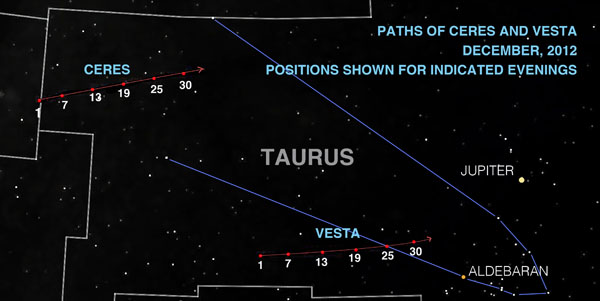![]() LISTEN to this week’s Sky Report
LISTEN to this week’s Sky Report
This is the Griffith Observatory Sky Report for the week ending Wednesday, December 19, 2012. Here is what’s happening in the skies of Southern California:
The Geminid meteor shower should be seen near its peak on the late night and early morning hours of both Wednesday and Thursday, December 12-13 and 13-14. Meteors can be seen nearly all night, but will be in their greatest numbers (nearly 3 per minute in ideal conditions) both nights between 11 p.m. and 4 a.m., when the constellation Gemini the Twins, containing the meteor shower radiant, is nearly overhead. The numbers will drop by half by Friday night, and the shower will be nearly undetectable after that. From suburban conditions, the bright sky reduces these numbers to about a third of what is possible from a dark mountaintop or desert wilderness. From wherever you watch, the only equipment you need is a coat, blanket, and sleeping bag with which to keep warm, and a reclining chair or deck lounge to rest on, holding your gaze high in the sky. Griffith Park will not be open for the meteor shower.
The planet Jupiter, in Taurus the Bull, is noticeable in the east-northeast as twilight deepens. The brilliant planet is nearly overhead at 11:00 p.m., and gradually moves westward, setting in the west-northwest at dawn. Binoculars are enough to reveal Jupiter’s four largest moons, and a telescope will show the dark cloud belts, the red spot, and many other cloud features across the stormy face of the planet.
The two largest members of the main belt of asteroids between Mars and Jupiter, dwarf planet Ceres and asteroid Vesta, are not far from Jupiter in the sky in Taurus. Both are bright enough to easily see in binoculars, and may be found with the aid of the accompanying chart, courtesy of the December Griffith Observer magazine. The NASA/JPL Dawn mission completed studies of Vesta last summer, and is now using ion thrusters to move to orbit around Ceres.
The moon is new on Wednesday, December 12. The time of moonset advances from 5:32 p.m. on Thursday the 13th to midnight between Tuesday the 18th and Wednesday the 19th. The phase of the moon during this period waxes from crescent to first-quarter.
Southern California residents can see the star nu Aquarii as the moon covers it on the evening of Sunday the 16th. The star is magnitude 4.5–just bright enough to see by unaided eye in suburban conditions, and will be easy to see next to the center of the unlit side of the moon through binoculars or a telescope until 6:25 p.m. Then the star will suddenly blink out as the moon moves across it–a kind of eclipse known as an occultation. The occultation will end at 7:31 p.m., P.S.T. when nu Aquarii re-appears from behind the middle of the moon’s bright crescent.
The asteroid 4179 Toutatis came within about 4 million miles from us on Tuesday night, December 11, but will remain visible through medium-sized amateur telescopes for the next week at about magnitude 10.6. Toutatis will quickly move through the constellations Cetus, Pisces, Aries, and Taurus during this time. Because the asteroid is relatively close compared to other solar system objects, potential observers should generate a custom ephemeris correct for their observing location by using JPL’s Internet-accessible on line calculation service Horizons at http://ssd.jpl.nasa.gov/horizons.cgi.
This week marks the 40th anniversary of Apollo 17, the last Apollo, landing on the moon. Griffith Observatory Astronomical Lecturer, Dr. David Reitzel, and I will present different free talks in the Leonard Nimoy Event Horizon Theater to honor the mission on Saturday and Sunday, December 15 and 16. Please see the schedule on our event webpage, http://www.griffithobservatory.org/exhibits/special/apollo17.html , or call (213) 473-0800 for program information.
Los Angeles residents may have a chance to see the secret Air Force mini-robotic space plane, the X-37b as it makes a pass 220 miles above southern California on the morning of Thursday, December 13. The satellite, appearing at least as bright as a star of the Big Dipper, will cross the sky from west-southwest to east-northeast between 6:03 and 6:08 a.m., P.S.T. It reaches the apex of its arc 64 degrees above the northwest horizon at 6:05 a.m. From Los Angeles, the path of X-37b will pass the star Procyon, the bowl of the Big Dipper, and the star Vega. Another satellite launched in the last few days, the first by North Korea, will not be observable from southern California until next spring.
6:00 a.m. is also a good time to see the brightest planet, Venus, low in the southeast. The first bright object to the upper right of Venus is the ringed planet Saturn, while Mercury can be glimpsed to Venus’s lower left.
Free views of the sun during the day and of the moon, planets, and other celestial objects at night, are available to the public in clear weather five days a week–Wednesday through Sunday– through Griffith Observatory’s telescopes before 9:30 p.m. The next Griffith Observatory public star party, hosted by Los Angeles Astronomical Society, the Sidewalk Astronomers, and the Planetary Society, is scheduled for Saturday, December 22.
From Griffith Observatory, I’m Anthony Cook and I can be reached at griffithobserver@gmail.com.
